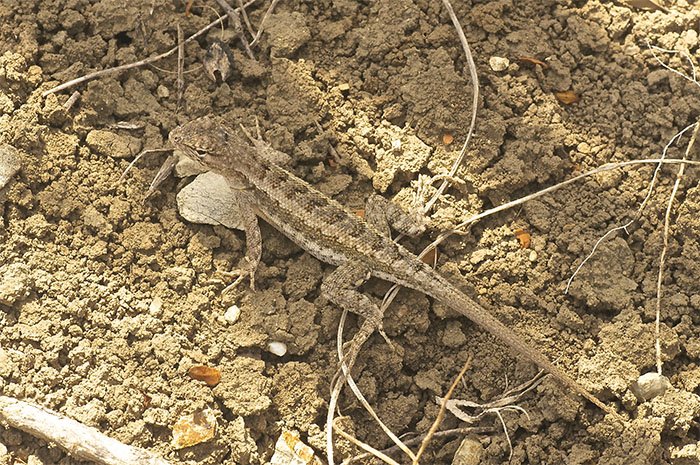Camo Lizard
Photo credit Zelimir Cernelic., CC BY 3.0 https://creativecommons.org/licenses/by/3.0, via Wikimedia Commons
Tropiduridae
by Inspector Barry Mins on May 10, 2022Hey kids, welcome back to our series on the mysteries of created kinds!
This week we’re heading to South America to look for a large kind of lizard. There are enough species and enough members of each to find them in most countries of South America.

These lizards have a varied diet consisting largely of insects, but also of plants.1 Ants are a primary source of food for at least some species, while others prefer flowers.2 In other species, leaves are the preferred food.3 The diet varies based on habitat and species preference.
Like all lizards, this kind needs to warm itself up in the sunshine. To do this, many species like to inhabit rocky outcrops and use the rocks for basking.4 Some species also live in intertidal zones, using the rock pools to hunt for food.5 The most important way these lizards get heat is from the substrate, so habitat choice matters!6
When threatened by predators, these lizards can lose their tails to distract their pursuers.7 They also have a special gland to send chemical signals that they likely use to communicate with one another.8
Many species in this kind are sexually dimorphic, either in color or in body shape, with males generally being more colorful and thin.9 In some species, males and females are roughly the same size.10 The females can lay anywhere from two11to six eggs.12
Has anyone figured it out yet? This week is hard just because this kind does not show up on nature documentaries much. This week’s kind is the Tropiduridae, a group of lizards without a common name, though some genera have common names.

Can you find the lizard?
Pavel Kirillov from St.Petersburg, Russia, CC BY-SA 2.0 https://creativecommons.org/licenses/by-sa/2.0, via Wikimedia Commons
Try out this fun word search!
Clue
Your clue for the next week is:
This kind is a rodent that resembles a chinchilla.
Ask a Question
Have you ever had a question about created kinds but didn’t know who to ask? Have you ever wanted to learn more about your favorite kind? Well, now you can! You can ask me, Inspector Barry Mins, a question! Have your parents help you fill out this form, and you might get your question answered in my column! If you have any questions about created kinds, feel free to send them my way!
Footnotes
- Antonia Beuttner and Claudia Koch. “Analysis of diet composition and morphological characters of the Peruvian lizard Microlophus stolzmanni (Squamata: Tropiduridae),” Phyllomedusa 18, no. 1 (2019): 47–62.
- M. Van Sluys, C. F. D. Rocha, D. Vrcibradic, C. Aleksander, B. Galdino, and A. F. Fontes. “Diet, activity, and microhabitat use of two synoptic Tropidurus species (Lacertilia: Tropiduridae),” Journal of Herpetology 38, no. 4 (2004): 606–611.
- M. F. Kolodiuk, L. B. Ribeiro, and E. M. X. Freire. “Diet and foraging behavior of two species of Tropidurus (Squamata, Tropiduridae) in the Caatinga of Northeastern Brazil,” South American Journal of Herpetology 5, no. 1 (2010): 35–44.
- Van Sluys, “Diet, activity, and microhabitat,” 606–611.
- J. M. Farina, M. Sepulveda, M. V. Reyna, K. P. Wallem, and P. G. Ossa-Zazzali. “Geographical variation in the use of intertidal rocky shores by the lizard Microlophus atacamensis in relation to changes in terrestrial productivity along the Atacama Desert coast,” Journal of Animal Ecology 77 (2008): 458–468.
- C. S. Bujes, and L. Verrastro. “Thermal biology of Liolaemus occipitalis (Squamata, Tropiduridae) in the costal sand dunes of Rio Grande do Sul, Brazil,” Brazilian Journal of Biology 66, (2006) 3.
- C. A. B. Galdino, E. G. Pereira, A. F. Fontes, and M. Van Sluys. “Defense behavior and tail loss in the endemic lizard Eurolophosaurus nauzae (Squamata, Tropiduridae) from southeastern Brazil,” Phyllomedusa 5, no. 1 (2006): 25–30.
- A. L. G. Carvalho, A. M. Jeckel, C. Nisa, M. C. Luna, and C. Piantoni. “A novel epidermal gland type in lizards (α-gland): structural organization, histochemistry, protein profile and phylogenetic origins,” Zoological Journal of the Linnean Society 192, no 4 (2021): 1137–1166.
- A. C. S. Pinto, H. C. Wiederhecker, and G. R. Colli. “Sexual dimorphism in the Neotropical lizard, Tropidurus torquatus (Squamata, Tropiduridae),” Amphibia-Reptilia 26 (2005): 127–137.
- K. S. Toyama, and C. K. Boccia. “Sexual size dimorphism and life history traits in an island-mainland system: an overview of the lizard genus Microlophus,” Amphibia-Reptilia 42, no. 4 (2021): 511–517.
- C. A. B. Galdino, V. B. Assis, M. C. Kiefer, and M. Van Sluys. “Reproduction and fat body cycle of Eurolophosaurus nanuzae (Sauria; Tropiduridae) from a seasonal montane habitat of southeastern Brazil,” Journal of Herpetology 37, no. 4 (2003): 687–694.
- H. C. Wiederhecker, A. C. S. Pinto, G. R. Colli. “Reproductive ecology of Tropidurus torquatus (Squamata: Tropiduridae) in the highly seasonal cerrado biome of central Brazil,” Journal of Herpetology 36, no. 1 (2002), 82–91.
- © 2025 Answers in Genesis
- Privacy Policy
- Contact
- About
